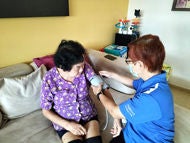What is - Klinefelter Syndrome
What is Klinefelter syndrome?
Klinefelter syndrome is a chromosomal condition that describes boys and men with common features, physical traits and medical conditions that are caused by the presence of an extra X chromosome (i.e., XXY).
Both males and females generally have 46 chromosomes. In females, this includes two X chromosomes, while males have one X and one Y chromosome.
What are the types of Klinefelter syndrome?
The most common form is the classic type, but there are variations.
- Classic Klinefelter syndrome (47,XXY): This is the usual type, where a male has one extra X chromosome in all or most of their cells.
- Mosaic Klinefelter syndrome: In this type, some cells have an extra X chromosome (47,XXY), while others are normal (46,XY). This often causes milder symptoms.
- Other variations: Rarely, males may have more than one extra X chromosome and may result in more severe symptoms.
How common is Klinefelter syndrome?
It is estimated that one in 500 to 1,000 males are born with KIinefelter syndrome.
Symptoms of Klinefelter Syndrome
What are the symptoms of Klinefelter syndrome?
Klinefelter syndrome does not usually cause any obvious symptoms early in childhood, and many boys and men often do not realise they have KIinefelter syndrome until they go through puberty. In these instances, puberty may be late or incomplete. Sometimes, the condition may only be diagnosed in adulthood due to infertility. The features of KIinefelter syndrome can vary and it is important to note that not all the features described will be seen in your child.
Most boys with KIinefelter syndrome can expect to live long and healthy lives.
The typical features of KIinefelter syndrome in an adult (if untreated) are:
- Growth: A tall and thin body with disproportionate long arms and legs.
- Physical features: Breast tissue development (gynaecomastia) and female pattern of fat distribution. Reduced facial and body hair.
- Small testicles: This feature is present in most people with KIinefelter syndrome.
Children and adolescents with KIinefelter syndrome may experience:
- Learning difficulties
- Delayed motor development
- Difficulties with speech and reading
- Poor muscle tone
- Lower attention span
- Behavioural problems
In adulthood, in addition to the main typical features, untreated adults may have:
- Hypogonadism. Individuals with KIinefelter syndrome often have this condition where men are unable to produce enough of the male hormone, testosterone, for the body’s needs. Testosterone is important for normal reproductive and sexual function, and physical changes that happen during male puberty such as development of the penis and testes, and facial and body hair. It also helps the growth of bone and muscles. Hence, men with KIinefelter syndrome have underdeveloped testes, low libido (sex drive), infertility and osteoporosis (thinning of the bones). Almost all men with KIinefelter syndrome will be infertile (sterile), which means they will be unable to father a child without medical help.
- Physical features. A physique which is less muscular than other men.
- Intelligence. Most men with KIinefelter syndrome have normal intelligence, though some may have their intelligence affected.
- Anxiety and depression
What are other medical concerns associated with Klinefelter syndrome?
The following problems can also be seen in individuals with KIinefelter syndrome and need to be monitored for and treated if present:
- Cardiovascular diseases such as ischaemic heart disease, peripheral vascular disease and pulmonary embolism
- Metabolic syndromes such as dyslipidaemia and diabetes mellitus
- Breast cancer
- Thromboembolism (blood clots in blood vessels)
- Autoimmune diseases such as systemic lupus erythematosus, rheumatoid arthritis and Sjogren’s syndrome
When should you see a doctor?
If you notice symptoms of Klinefelter syndrome in yourself or your child, please consult a healthcare professional or specialist for further testing and diagnosis.
Klinefelter Syndrome - Causes and Risk Factors
What causes Klinefelter syndrome?
Klinefelter syndrome is caused by a random genetic error that results in a male having an extra X chromosome. Normally, males have one X and one Y chromosome (46,XY), but individuals with Klinefelter syndrome have an additional X chromosome (47,XXY). This extra chromosome occurs due to an error during the formation of sperm or egg cells.
The condition is not inherited and happens spontaneously during the process of cell division. In some cases, the chromosomal abnormality may occur after fertilisation, leading to mosaic klinefelter syndrome, where some cells have the typical 46, XY chromosomes, and others have 47, XXY.
What are the risk factors for Klinefelter syndrome?
Women above the age of 35 when they become pregnant have a slightly higher chance of having a child with chromosomal abnormalities, including Klinefelter syndrome. However, this increased risk is small.
There are no specific lifestyle or environmental factors that increase the likelihood of Klinefelter syndrome, as it results from random errors in cell division. Since the condition is not inherited, family history does not typically play a role.
Diagnosis of Klinefelter Syndrome
How is Klinefelter syndrome diagnosed?
The diagnosis of KIinefelter syndrome is made by looking at the complete set of chromosomes of the individual. This is called a karyotype. A karyotype shows the number and visual appearance of the chromosomes found in the cells of a person.
- Before birth
Diagnosis can be made by taking a sample of amniotic fluid, or other foetal tissue, to look at the foetal karyotype. - After birth
Diagnosis is confirmed by taking a sample of blood or other tissue to obtain a karyotype.
Karyotype showing KIinefelter syndrome
Treatment for Klinefelter Syndrome
Can Klinefelter syndrome be cured?
While it is not possible to cure KIinefelter syndrome, much can be done to make sure your child has the best possible outcome.
How is Klinefelter syndrome managed?
The multidisciplinary medical team will be able to address specific medical concerns and routine KIinefelter syndrome -related healthcare issues.
Below are some related medical issues and how they can be managed:
| Medical issue |
Treatment |
|---|---|
| Developmental delay | Early intervention therapies |
| Hypogonadism | Testosterone replacement |
| Infertility | Assisted reproductive therapy |
Early intervention therapies for developmental delays
Speech and occupational therapy are helpful for children and adults who experience delays in speech or challenges with motor skills.
Learning difficulties can also often be managed through tailored educational programmes and support from teachers or specialists.
Testosterone therapy
Testosterone can be given in the form of injections or tablets. It is usually started from puberty and continued through adulthood.
Testosterone replacement can help to:
- Increase strength and build a more muscular body type
- Increase facial and pubic hair growth
- Increase libido (sex drive)
- Promote feelings of well-being
Assisted reproductive therapy
Although most individuals with Klinefelter syndrome are infertile, some may be able to father children through assisted reproductive techniques, such as testicular sperm extraction (TESE) combined with in vitro fertilisation (IVF).
Counselling and emotional support
Therapy or counselling can help manage emotional challenges, low self-esteem and social difficulties. Support groups may also provide valuable assistance.
Regular medical check-ups
Regular medical check-ups are essential to monitor health and address potential complications, such as osteoporosis or cardiovascular issues. Early intervention and consistent care can significantly improve outcomes for individuals with Klinefelter syndrome.
FAQs on Klinefelter Syndrome
Recurrence risk is low (<1%). However, risk has been shown to increase with increasing maternal age.
Klinefelter syndrome cannot be prevented, as it occurs due to a random error during the formation of reproductive cells. This error happens when the chromosomes fail to divide properly, leading to an extra X chromosome. It is not caused by anything the parents have done before or during pregnancy.
Although the condition cannot be prevented, early diagnosis and treatment can help manage symptoms and improve quality of life. Regular medical care, hormonal therapy and support for learning or developmental challenges can make a significant difference for individuals with Klinefelter syndrome.
Klinefelter Syndrome - Other Information
Klinefelter syndrome is a lifelong condition. Should you require financial assistance or emotional support, please approach your doctor for referral to a medical social worker.
| Support Group |
|---|
| Club Rainbow Singapore Club Rainbow Singapore supports and empowers children with chronic illnesses and their families by providing relevant compassionate services in their journey. Tel: 6377 1789 Email: contact@clubrainbow.org www.clubrainbow.org |
Download the Klinefelter Syndrome brochure.
References
47, XXY (klinefelter syndrome) - symptoms, causes, treatment. National Organization for Rare Disorders. (2024, July 15). https://rarediseases.org/rare-diseases/47-xxy-klinefelter-syndrome/
About klinefelter syndrome. Genome.gov. (n.d.). https://www.genome.gov/Genetic-Disorders/Klinefelter-Syndrome
Osunkoya, A. O. (2023). Klinefelter syndrome. Uropathology, 460–461. https://doi.org/10.1016/b978-0-323-65395-4.00216-5
Ross, J. L. (Ed.). (2021, September). Klinefelter syndrome (for parents) | nemours kidshealth. KidsHealth. https://kidshealth.org/en/parents/klinefelter-syndrome.html
Contributed by
The information provided is not intended as medical advice. Terms of use. Information provided by SingHealth.
Get to know our doctors at SingHealth Hospitals in Singapore.
Get to know our doctors at SingHealth Hospitals in Singapore. here.





















